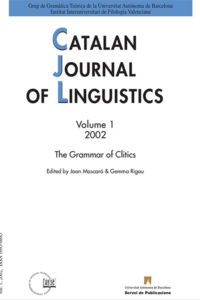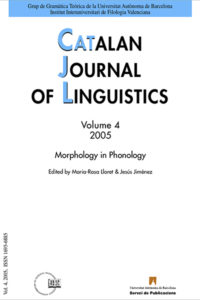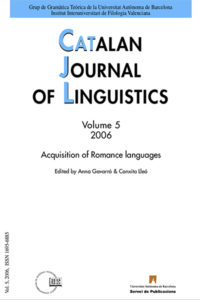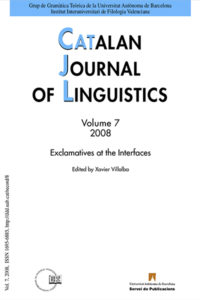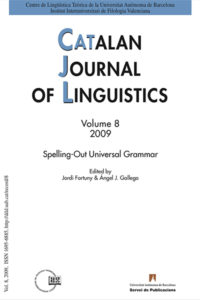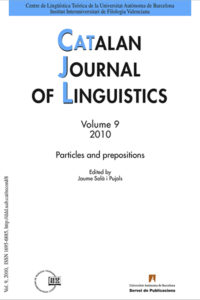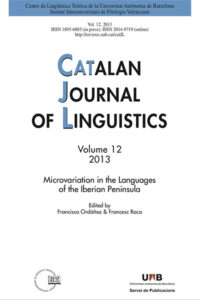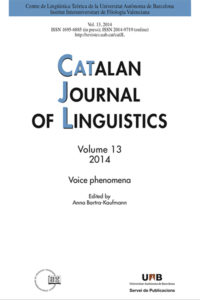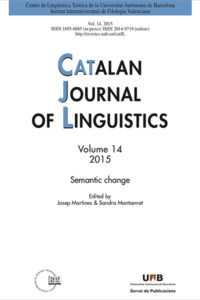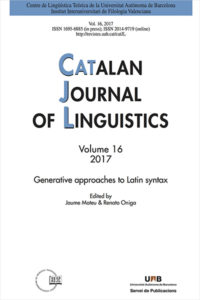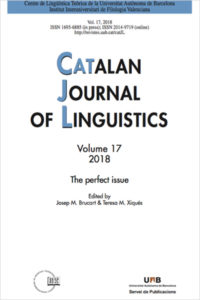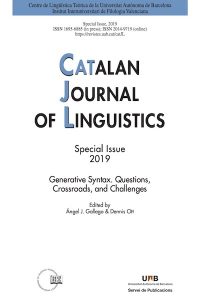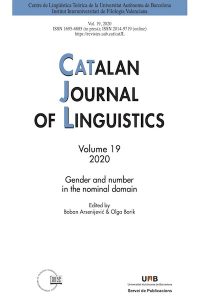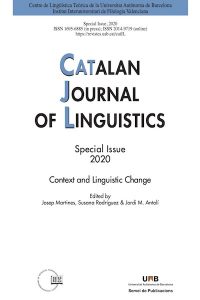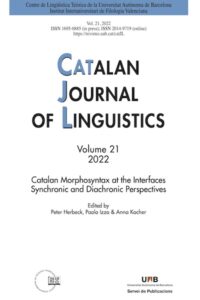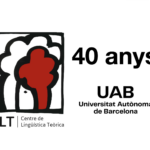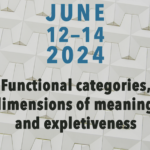25 maig, 2007

Autors:
Maria Josep Cuenca (ed.)
Títol:
Contrastive perspectives on discourse markersEditorial: Universitat Autònoma de Barcelona, Servei de Publicacions
Col·lecció: Catalan Journal of Linguistics #06Data de publicació: 2007
Pàgines: 172 Text complet
Articles
Italian allora, French alors: Functions, convergences and divergences
Carla Bazzarella, Cristina Bosco, Alessandro Garcea, Barbara Gili Fivela, Johanna Miecznikowski, Francesca Tini Brunozzi
9-30
The meaning and functions of the Swedish discourse marker alltså—Evidence from translation corpora
Karin Aijmer
31-59
Different functions, different histories. Modal particles and discourse markers from a diachronic point of view
Richard Waltereit, Ulrich Detges
61-80
Adaptive Management in Discourse: The case of involvement discourse markers in English and Spanish conversations
Jesús Romero-Trillo
81-94
Uses of also in oral semi-informal German
Marta Fernández-Villanueva
95-115
The translation of oh in a corpus of dubbed sitcoms
Anna Matamala
117-136
Discussion article: Discourse markers, modal particles, and contrastive analysis, synchronic and diachronic
Elizabeth Closs Traugott
139-157
Discussion article: Pragmatic markers, interjections and discourse
Neal R. Norrick
159-168
Títols de la col·lecció / Also in this series:
25 maig, 2008
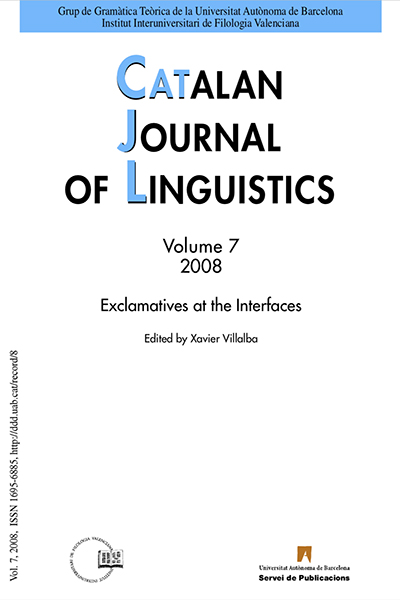
Autors:
Xavier Villalba (ed.)
Títol:
Exclamatives at the interfacesEditorial: Universitat Autònoma de Barcelona, Servei de Publicacions
Col·lecció: Catalan Journal of Linguistics #07Data de publicació: 2008
Pàgines: 203 Text complet
Articles
Exclamatives: A Thematic Guide with Many Questions and Few Answers
Xavier Villalba
9-40
Deconstructing Exclamations
Elena Castroviejo Miró
41-90
Exclamative Wh-Phrases as Positive Polarity Items
Raquel González Rodríguez
91-116
Spanish Root Exclamatives at the Syntax/Semantics Interface
Javier Gutiérrez-Rexach
117-133
Catalan “Déu n’hi do” and Conventional Implicatures in Exclamatives
Laia Mayol
135-156
Pleonastic tet in the Lapscheure dialect
Liliane Haegeman, Danièle Van de Velde
157-199
Títols de la col·lecció / Also in this series:
25 maig, 2009

Autors:
Jordi Fortuny & Ángel J. Gallego (eds.)
Títol:
Spelling-out Universal GrammarEditorial: Universitat Autònoma de Barcelona, Servei de Publicacions
Col·lecció: Catalan Journal of Linguistics #08Data de publicació: 2009
Pàgines: 191 Text completThis volume offers a collection of brief and orginal articles that aim at developing the minimalist approach to language. In this introduction, we would like to discuss certain issues concerning the Minimalist Program and the concept of Universal Grammar as well as to present the contributions of the volume.
The term minimalism is typically associated to certain artistic tendencies whose work is said to be stripped down to its most fundamental features. In the linguistic agenda developed by Noam Chomsky and others since the early nineties, this term is endowed with the same aesthetic concern of searching for the most fundamental features of grammatical theory, but it crucially adds a substantive commitment to investigate to what extent language is—in a sense we clarify below—a perfect system.
In Martin & Uriagereka (2000) this bifurcated path to pursue the Minimalist Program (MP) is emphasized by establishing a distinction between methodological minimalism and substantive minimalism. The methodological facet is concerned with the “theory of language” under construction, whereas the substantive facet is concerned with how well designed “language itself” is. Methodological minimalism seeks those components of a linguistic theory that are redundant, stipulative, and idiosyncratic, in order to eliminate or reformulate them in the form of parsimonius, well-grounded, and general principles. Substantive minimalism explores whether an alleged property of language is a genuine property or an apparent property, and if genuine, whether it satisfies the Strongest Minimalist Thesis—SMT (see Chomsky 2000)—, i.e., whether it is an optimal solution to the requirements imposed by the external systems.
Títols de la col·lecció / Also in this series:
25 maig, 2010
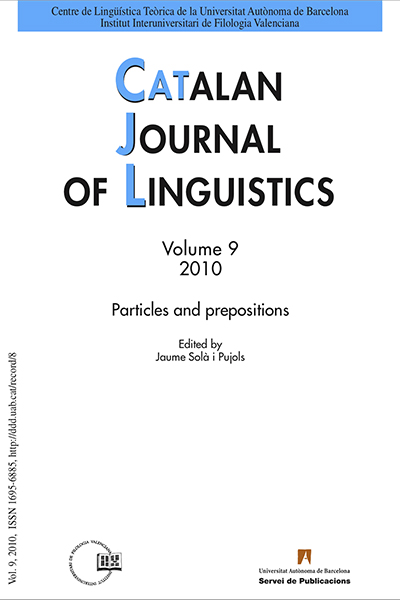
Autors:
Jaume Sola i Pujols (ed.)
Títol:
Particles and prepositionsEditorial: Universitat Autònoma de Barcelona, Servei de Publicacions
Col·lecció: Catalan Journal of Linguistics #09Data de publicació: 2010
Pàgines: 192 Text complet
Index. Particles and prepositions
7 Bosque, Ignacio. On disjunctive dependencies.
23 Dikken, Marcel den. Directions from the GET-GO. On the syntax of manner-of-motion verbs in directional constructions.
55 Fábregas, Antonio. On Spanish Prepositional Prefixes and the Cartography of Prepositions.
79 Gallego, Ángel J. On the prepositional nature of non-finite verbs.
103 Pavón Lucero, María Victoria. Why Are There No Locative Conjunctions in Spanish?
125 Real Puigdollers, Cristina. A microparametric approach on goal of motion constructions: properties of adpositional systems in Romance and Germanic.
151 Rigau, Gemma; Suïls, Jordi. Microvariation in Catalan and Occitan complementizers: the so-called expletive se.
167 Terzi,Arhonto. On null spatial PS and their arguments.
189 Resums
Títols de la col·lecció / Also in this series:
25 maig, 2011

Autors:
Montserrat Batllori & M. Lluïsa Hernanz (eds.)
Títol:
Generative diachronic syntax: word order and information structureEditorial: Universitat Autònoma de Barcelona, Servei de Publicacions
Col·lecció: Catalan Journal of Linguistics #10Data de publicació: 2011
Pàgines: 249 Text completIn recent times, there has been an increasing concern for the interaction between information structure and syntax, and its effect in language change. The aim of this volume is to provide the reader with comparative research into the role of informa- tion structure in language change from a crosslinguistic perspective and to con- tribute to a better understanding of structural changes and their possible relation to information structure factors.
From a synchronic standpoint, information packaging is jointly conveyed by semantics, prosody and syntax. In contrast, diachronic linguistics lacks the evidence of prosodic information, but it can still rely on the relation between discourse semantics and syntax in old written texts, as well as on the comparison with syn- chronic data, to set light on the phenomena involved in syntactic changes driven by information structural configurations.
Concerning language change, it is generally accepted that the focus of inves- tigation is on I-language and that language acquirers select cues that are robustly represented in main clauses of the Primary Linguistic Data of their environment so as to feed into particular parameters of UG (see Fischer et al. 2000, Batllori et al. 2005, Kemenade 2007 and Roberts 2007). From this cue-based acquisition perspec- tive, it could be the case that information structural factors might constitute triggers for syntactic changes (for example, word order change –see Westergaard 2010).
The analysis of discursive information in written texts has increased in recent years due to the contribution of the cartographic approach (from Rizzi 1997 onwards) and the studies related to the CP field within the minimalist program. These two approaches, even though apparently in conflict, are actually comple- mentary in many respects. As Cinque and Rizzi (2008: 49) observe, «Minimalism focuses on the generating devices, and cartography focuses on the fine details of the generated structures, two research topics which can be pursued in parallel in a fully consistent manner, and along lines which can fruitfully interact».
Títols de la col·lecció / Also in this series:


